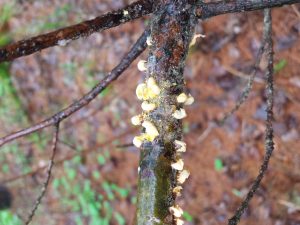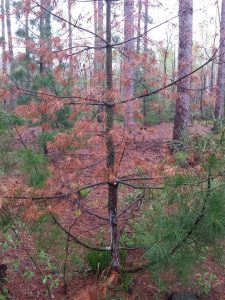
White pine blister rust fruit body.
White pine blister rust (Cronartium ribicola; WPBR), a naturalized pine rust disease, has been infecting white pine saplings in several northwest Wisconsin counties this spring. Although WPBR is common in the Lake States and can in some cases cause significant losses in white pine, taking several steps can help prevent infections before they start and manage them before damage occurs.
Like many foliar diseases, WPBR infections are promoted by moist and cool spring weather that results in persistent wetness on foliage; specifically, at least 2 days of wetness while air temperatures are under 68oF. Maintaining dense stocking (6×6) reduces incidence of infection by increasing the mortality of lower branches, most susceptible to infection. Similarly, successive pruning of lower branches beginning at age 5 to a minimum branch height of 9 ft. prevents leaf contact with moist surface vegetation and can increase airflow, hastening foliar drying. If caught early enough, infections can be stopped before reaching the main stem by pruning out flagging twigs and branches to at least 4 inches past the interior-most wilting needles; if the main stem is closer than 4 inches from the interior-most canker or wilted foliage, unmanageable stem infection may already have occurred and the tree cannot be saved.

White pine sapling infected with blister rust. Photo by Kyle Young.
Written by Paul Cigan, forest health specialist, Hayward (Paul.Cigan@Wisconsin.gov), 715-416-4920.
